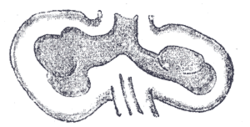Respiratory bud
| Respiratory bud | |
|---|---|

Lung buds from a human embryo of about four weeks, showing commencing lobulations.
|
|

Lungs of a human embryo more advanced in development.
|
|
| Details | |
| Days | 28 |
| Precursor | Ventral part of the Foregut |
| Identifiers | |
| Latin | Gemma respiratoria, gemma pulmonalis |
| Code | TE E5.5.3.0.0.0.3 |
|
Anatomical terminology
[]
|
|
The respiratory bud is an embryological structure of endodermal origin that develops into organs of the respiratory system, such as the larynx, trachea and lungs.
In the fourth week of development, the respiratory bud or diverticulum, starts to grow from the ventral (front) side of the foregut into the mesoderm that surrounds it, forming the lung bud. Around the 28th day, the lung bud splits into two bronchial buds that develop on the sides of the distal part of the respiratory bud and begin to grow laterally, expanding into the primitive pleural cavity.
The molecular signaling involved in the specification of the respiratory bud starts with the expression of the Nbx2-1 gene, which determines the respiratory field – the area where the respiratory bud will begin to grow from. The signaling that makes the growth of the respiratory bud possible is complex and involves a number of interactions between the mesoderm and the respiratory bud epithelium, in which members of the Fgf and Fgfr family of genes express.
At first, the posterior part of the trachea is open to the esophagus, but as the bud elongates two longitudinal mesodermal ridges begin to form and grow until they join, forming a wall between the two organs. An incomplete separation of the organs leads to a congenital abnormality known as a tracheoesophageal fistula.
The epithelium of the larynx is of endodermal origin, but the laryngeal cartilages, unlike the rest of the respiratory bud connective tissue, come from the mesenchyme of the fourth and sixth pharyngeal arches. The fourth pharyngeal arch, adjacent to what will be the root of the tongue, will become the epiglottis. The sixth pharyngeal arch, located around the laryngeal orifice, will become the thyroid, cricoid and arytenoid cartilages. These structures are formed in a process in which the lining cells of the primitive larynx proliferate and occlude it. Later, it recanalizes leaving two membrane-like structures: the vocal folds and the vestibular folds. In between, an enlarged space, the ventricle, remains. Failure in this process leads to a serious but rare condition called congenital atresia of the larynx.
...
Wikipedia
